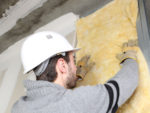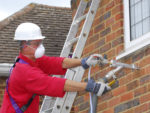Insulating and draught proofing are one of the most efficient and effective DIY projects for saving money in your home and improving the energy performance. It is possible to insulate or draught proof almost every part of your home, from floors and walls to lofts and windows. Our Insulation and draught proofing section covers most aspects of insulating your home being retrospectively or as your build. There are lots of ideas for projects and how to fit insulation and draught proofing measures.

Cavity wall insulation in place in a timber framed building
Why Insulation is important:
Insulating a home is important for a number of reasons:
- Keep warmer: Insulating your home reduces the rate at which heat is conducted from inside, where you need it, to outside. The more insulation that you have the slower the rate of heat loss. It’s a bit like putting another blanket on your bed to stay warm on a colder winter’s night. Currently the government recommend 270mm, or just over 10 inches, of insulation in your loft
- Save money: By reducing heat loss you do not need to replace the heat that is lost so quickly and therefore you have to use the heating less. The less you use the heating the less fuel you burn so the less you spend on energy. Insulation will typically pay for itself within 4 years, or less if you fit it yourself and it will keep on saving you money for the next 40 years or more, if you’re still around to feel the effects
- Insulation is green: The less fuel you burn doesn’t just mean that you have cheap energy bills, it also means that less CO2 and other pollutants are generated from running your boiler. Not only do you save money, but you can feel good about it too!
- Optimise the Temperature: When a home is insulated the temperature will remain more constant for longer because the heat isn’t being lost so quickly. This leads to a much more pleasant living environment particularly in winter when it is cold. It will also keep the heat out, keeping your home cooler during a heat wave
- Sound Proofing; Insulating walls and ceiling can assist with sound proofing
- Reducing Condensation: Insulating walls can reduce the condensation building up on inside of the walls as they will not be so cold. When the warm moist air from inside touches cold walls condensation can form, but is the walls are insulated the walls will remain warmer for longer and less condensation will form
- Improve your house price: By fitting insulation to your home your will most likely improve your EPC (Energy Performance Certificate) rating. There is some evidence that increasing the EPC rating can increase the value of your home. In a study by the Department Energy and Climate Change (DECC) suggested the improvement in EPC rating could increase the value of the average property in the region of 14%
In conjunction with Be Energy Smart, DIY Doctor has created an energy assessment that helps you to understand which energy improvement measure is right for your home. It takes one a few minutes to complete the assessment and you could see what you could save by adding extra insulation to your home.
Damp and Cavity wall insulation:
One of the major fears about cavity wall insulation is that it will not actually reduce condensation and damp in your home, but it might cause damp. This happens because the cavity wall insulation forms a cold bridge(or sometimes called a thermal bridge) across the cavity more effectively conducting the heat away from the room inside. This means that the inside wall will be colder and condensation will form when the warm moist air from inside meets it; it is the condensation that leads to damp and potentially mould growth on the wall. For more information about reducing condensation have a look at the project on stopping condensation.
The good news it is pretty rare for this situation to occur when cavity wall insulation is retrospectively injected. Circumstances where a cold bridges might be more likely to form are if the insulation in the cavity can gets wet and then it is the moisture in the insulation that actually creates the cold bridge. If you home is exposed to driven rain water might seep through the outer wall and infiltrate the cavity.
Another possibility is that loose material might have accumulated in the cavity which could form a bridge. Injecting insulation material into the cavity might disturb this material and press it against the walls to make the thermal bridge more effective.
Before having cavity wall insulation injected it is important to have the property assessed and the installer will be able to confirm the likelihood of any issues.
Why is draught proofing important?
Draught proofing is a really effective way of saving energy and heating bills. If you can reduce the rate of air change (the rate the air in your home is replace with cold air from outside) you will not have to heat so much air to keep your home warm. This means that you don’t need to spend quite so much on heating.
Here are some great suggestions for draught proofing your home:
- Fit draught proofing strips around doors and windows
- Use draught excluders between heated and unheated rooms inside
- Around you letter box install a flap or brush for stop the air coming through
- Put a flap over key holes
- Consider fitting a chimney balloon which stops the wind blowing down the chimney – remember to remove it before you light a fire and on Christmas eve
- Fill cracks in floors and skirting boards
- Remember to draught proof your loft hatch – hot air rises and a lot can be lost though your hatch.
Most homes need a certain amount of ventilation therefore it is important that you do not cover air brick and extractor fans. These are required to remove moisture and allowing your home to breath. For information about air bricks have a look our project on the installation and maintenance of airbricks.
Draught proofing and Insulation are such effective way to improve the energy performance of your home, these should be DIY projects at the top of your list. There are plenty of reasons why to carry out a DIY insulation or Draught proofing project and this section will give you information about how to go about these energy saving measures.









